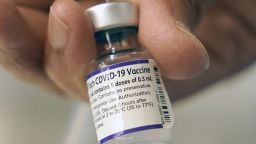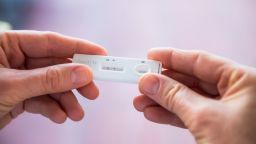The US Centers for Disease Control and Prevention updated its guidance for Covid-19 prevention in schools offering kindergarten through 12th-grade classes on Thursday, aligning the recommendations with the agency’s recently updated Covid-19 quarantine and isolation guidelines for the general public. It also expands its recommendations for screening testing and urges canceling or going virtual with some extracurricular and sports activities in order to protect in-person learning.
“We had a Delta surge in the fall, and we were able to successfully keep our schools safely open, our children in schools safely open, and we did that even before we had vaccine for our children,” CDC Director Dr. Rochelle Walensky said on NBC’s “Today” on Friday. “So right now, among the things that are really important to do to keep our schools safely open is to get our children 5 to 11 vaccinated, to get our teens 12 to 17 vaccinated and then to use all of those prevention strategies.”
The updated guidance comes as school districts across the country return from holiday breaks, many of them to virtual teaching because of rising Covid-19 cases or large numbers of teachers and staff in isolation or quarantine. US Education Secretary Miguel Cardona had said on “Fox News Sunday” that the Biden administration’s goal was to keep all schools open for in-person learning, but he acknowledged that there would be “bumps in the road” as they attempted to reopen.
The CDC’s new K-12 school recommendations say children who have not been fully vaccinated and are exposed to the coronavirus should quarantine for at least five days after their last close contact with a person who has Covid-19. Adults who are not vaccinated against Covid-19 or who have not received a booster shot are advised to follow this recommendation, too.
Previously, the CDC K-12 guidance recommended a 14-day at-home quarantine for people exposed to the coronavirus who were not fully vaccinated.
The new K-12 recommendations say students, teachers and staff with Covid-19 should stay home and isolate away from others for at least five full days. Day 0 is considered the first day of symptoms or the day of a positive viral test for people who do not have symptoms. People whose symptoms are improving can leave isolation after five full days if they are fever-free for 24 hours. They should wear a mask around others for an additional five days.
Previously, the CDC K-12 guidance recommended at least a 10-day isolation period for people infected with the virus.
The agency also updated its screening testing recommendation for K-12 schools.
“In K-12 schools, screening testing can help promptly identify and isolate cases, initiate quarantine, and identify clusters to help reduce the risk to in-person education,” the new guidance states.
Previously, the K-12 recommendations said screening testing should be offered to students who have not been fully vaccinated when community transmission is at moderate, substantial or high levels. The guidance now says that, at a minimum, those students should be offered screening testing. It includes an updated chart that recommends screening testing for all students at least once per week in communities with moderate to high transmission.
Additionally, the new K-12 recommendations now recommend screening testing for all teachers and staff at least once per week. Previously, such screening was recommended only for teachers and staff who were not fully vaccinated.
Recommended screening testing for high-risk sports, such as football and wrestling, and high-risk extracurricular activities, such as singing or band, has also been updated. In previous guidance, screening was recommended at least once per week for participants who were not fully vaccinated and twice per week in areas with substantial coronavirus transmission. According to an updated chart in the recommendations, those screenings now include all participants, regardless of vaccination status.
In areas with high transmission, schools are now advised to cancel or hold high-risk sports and extracurricular activities virtually in order to protect in-person learning; previous guidance did not advise cancellations or virtual events in high-transmission areas if all the participants were fully vaccinated. Currently, the CDC says, more than 98% of counties have high Covid-19 transmission.
In areas with moderate-to-high transmission, previous guidance on low- and intermediate-risk sports had also recommended screening participants who were not fully vaccinated once per week. That recommendation now includes all participants, regardless of vaccination status.
“That is intended to really protect that critical in-person learning time,” Greta Massetti, the branch chief for the CDC’s Field Epidemiology and Prevention Branch, said during a CDC telebriefing on Friday. High-risk activities are those that involve increased exhalation, often in close contact and indoors.
“That is really one piece of a layered prevention strategy that schools can use,” Massetti said.
Separate from the CDC’s guidance, Children’s Hospital of Philadelphia and PolicyLab released Covid-19 school guidance aimed at preserving in-person schooling, saying that “outweighs the risks of infection to children and school staff at this stage of the pandemic.”
Get CNN Health's weekly newsletter
Sign up here to get The Results Are In with Dr. Sanjay Gupta every Tuesday from the CNN Health team.
The guidance aligns with the CDC on several points, including emphasizing that people with symptoms stay home, but it also urges discontinuing required weekly testing for people without symptoms and supports “mask to stay”-style policies that allow people exposed to Covid-19 to remain in class.
“With limited access to testing and schools overwhelmed with contact tracing and required testing solutions that are no longer feasible or sustainable, the time has come to pivot towards solutions that prioritize normalization of in-school education alongside practical safety measures that can manage the worst of this resurgence,” Dr. Jeffrey Gerber, associate director for inpatient research activities for the Center for Pediatric Clinical Effectiveness at Children’s Hospital of Philadelphia and co-author of the guidance, wrote in a blog post.
“Failure to pivot quickly risks closure of many under-resourced schools, which have been disproportionately impacted by staffing shortages, and whose communities have had more limited access to testing.”
CNN’s Jamie Gumbrecht contributed to this report.























